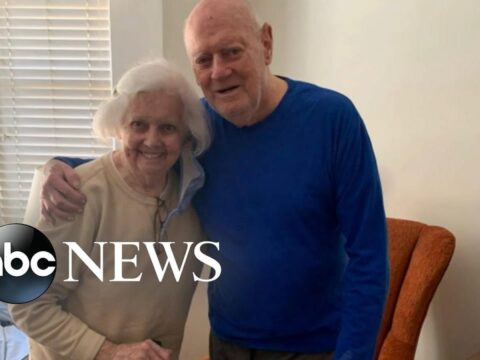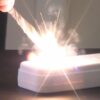A heart transplant recipient and his organ donor’s family had an emotional encounter at a baseball game, and it was completely by chance.
WATCH THE FULL EPISODE OF ‘WORLD NEWS TONIGHT’:
https://bit.ly/2ZVBHYm
WATCH OTHER FULL EPISODES OF WORLD NEWS TONIGHT:
http://abc.go.com/shows/world-news-tonight
#HeartTransplant #Donor #Inspiring #ABCNews





















Making me emotional
This gave me chillss !!
Man, I am Bawling! So heartbreaking and heartwarming!
Yes! Be an organ donor! To Register: http://www.organdonor.gov In Arizona, it's on the driver's license. Everything is linked to the National Organ Donor Registry, which has the specific organs/tissue I elected to donate. I chose to donate 100% of my organs, tissue, skin, eyes, everything, with no exclusions. However, a person could elect to donate only certain things. Whatever you are comfortable with, anything is better than nothing. I was surprised to learn how few people elect to donate their eyes. You can give multiple people the gift of sight by donating your eyes. The lenses, the corneas, optical nerves, lots of parts that make up our eyes can be used to help multiple people. I hope you'll consider being a "no exclusions" donor, like I am. My soul doesn't need anything from my earthly body, but what a gift I can leave behind on my way out. Here's the link: http://www.organdonor.gov
Thank you!
🙏🏽🙏🏽
As a grown man this is one of the most touching things I've ever seen. 😃😃
Our family lost our 2 1/2 month old Eve. We were able to save 7 lives with the gift of organ donation. The process was full of love and respect from the hospital staff and knowing we were helping others gave a bright light to a incredible tragedy.
Please donate. It's important and incredible.
👂❤
The heart is a muscular organ in most animals, which pumps blood through the blood vessels of the circulatory system.
Blood provides the body with oxygen and nutrients, as well as assisting in the removal of metabolic wastes.
In humans, the heart is located between the lungs, in the middle compartment of the chest.
In humans, other mammals, and birds, the heart is divided into four chambers: upper left and right atria; and lower left and right ventricles.
Commonly, the right atrium and ventricle are referred to together as the right heart, and their left counterparts as the left heart.
Fish, in contrast, have two chambers, an atrium and a ventricle, while reptiles have three chambers.
In a healthy heart, blood flows one way through the heart (due to heart valves, which prevent backflow).
The heart is enclosed in a protective sac, the pericardium, which also contains a small amount of fluid.
The wall of the heart is made up of three layers: epicardium, myocardium, and endocardium.
The heart pumps blood with a rhythm determined by a group of pacemaking cells in the sinoatrial node.
These generate a current that causes contraction of the heart, traveling through the atrioventricular node and along the conduction system of the heart.
The heart receives blood low in oxygen from the systemic circulation, which enters the right atrium from the superior and inferior venae cavae, and passes to the right ventricle.
From here, it is pumped into the pulmonary circulation, through the lungs (where it receives oxygen and gives off carbon dioxide).
Oxygenated blood then returns to the left atrium, passes through the left ventricle, and is pumped out through the aorta to the systemic circulation − where the oxygen is used and metabolized to carbon dioxide.
The heart beats at a resting rate close to 72 beats per minute.
Exercise temporarily increases the rate, but lowers resting heart rate in the long term, and is good for heart health.
Cardiovascular diseases (CVD) are the most common cause of death globally (as of 2008), accounting for 30% of all deaths.
Of these, more than three quarters are a result of coronary artery disease and stroke.
Risk factors include: smoking, being overweight, little exercise, high cholesterol, high blood pressure, and poorly controlled diabetes, among others.
Cardiovascular diseases frequently do not have symptoms, or may cause chest pain or shortness of breath.
Diagnosis of heart disease is often done by the taking of a medical history, listening to the heart-sounds with a stethoscope, ECG, and ultrasound.
Specialists who focus on diseases of the heart are called cardiologists, although many specialties of medicine may be involved in treatment.
I lost my brother 10 years ago. I’d give anything to hear his heart beat one more time! What a beautiful gift. That’s why I’m a donor too!!!
😭😭😭😭omg I cried so emotional and it’s a miracle
This story had me in tears! How amazingly beautiful
Wow man…💔
I’m such a sucker for love 💕
Amazing!!!
Getting teary eyed.
Organ Donation, a beautiful thing to do. My son in law breathes with donor lungs… so grateful. Worth more than can be expressed. Do it.
Omg! I'm a donor too!
Sarah Silverman doesn't think comedians should be judged on old tweets or jokes WoW Sarah Silverman is deep!
So so precious!!
This is wonderful!!! What a beautiful and touching story. Thank you so much for sharing this.
While this old dude got a 21 year old heart, thousands of younger people need the same transplant, but don't have the money or insurance. I don't think that's right.